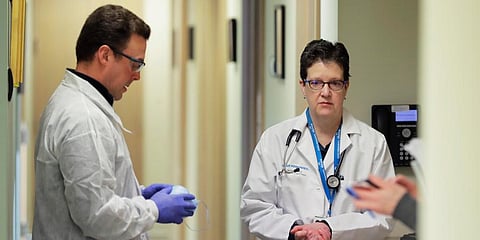

THIRUVANANTHAPURAM: The medical community in the state has come under the shadow of coronavirus infection. For the first time since COVID-19 threat, some medical personnel at Sree Chitra Tirunal Institute for Medical Sciences and Government Medical College Hospitals in Thiruvananthapuram and Ernakulam have been sent to isolation wards, triggering concern among health workers.
As medical professionals become infected or face isolation, the health department is heading for a major crisis. On one hand, it will have to keep in check a situation in which doctors/nurses/healthcare workers get infected and cause community transmission, and on the other, it will have to maintain its limited labour pool to deal with the pandemic. The department has decided to initiate steps to prepare a risk-assessment plan, thereby ensuring that there are enough employees to attend to the patients.
Meanwhile, the Kerala Government Medical Officers’ Association (KGMOA) has come out with the demand that the state government should develop better approaches to prevent COVID-19 exposure to medical professionals.
“The healthcare system is already understaffed. Doctors/nurses/technical staff getting categorised as high-risk contacts and low-risk contacts is a serious affair. What if they transmit the virus to patients? It will not only jeopardise a patient’s life but will also escalate the chances of community transmission,” said an officer-bearer of KGMOA. According to him, in the wake of the emerging situation, the health department must ensure an adequate supply of personal protective equipment (PPE) to medical professionals and healthcare workers.
“Doctors couldn’t avoid close contact with patients. For example, a doctor attending his/her OP will have to make close contact to know the condition of the patient. But at present, the doctors are using three-layer surgical masks. These have to be replaced with N95 respiratory masks. Ensuring adequate stock of PPE and its supply is also important,” added the office-bearer.
Avoid going to hospitals directly
At the same time, an officer at the Directorate of Health Services said though the situation is serious, it will not affect the ongoing prevention and control activities. The officer also added that the situation in which people having symptoms like fever, cough, running nose and others flock to hospitals should instead be avoided. “If they are that much concerned, they should contact Disha (1056) or the nearest primary/community healthcare centre. By coming to hospitals directly, they put themselves and others at risk,” said the officer. A doctor working at a COVID-19 isolation ward said, “Sending one or two doctors/nurses/technical staff is not to be worried about. But when we talk about more than 40 doctors, it is serious. There is an influx of COVID-19 symptomatic patients at government hospitals. Thus, a risk assessment plan must be put in place.”